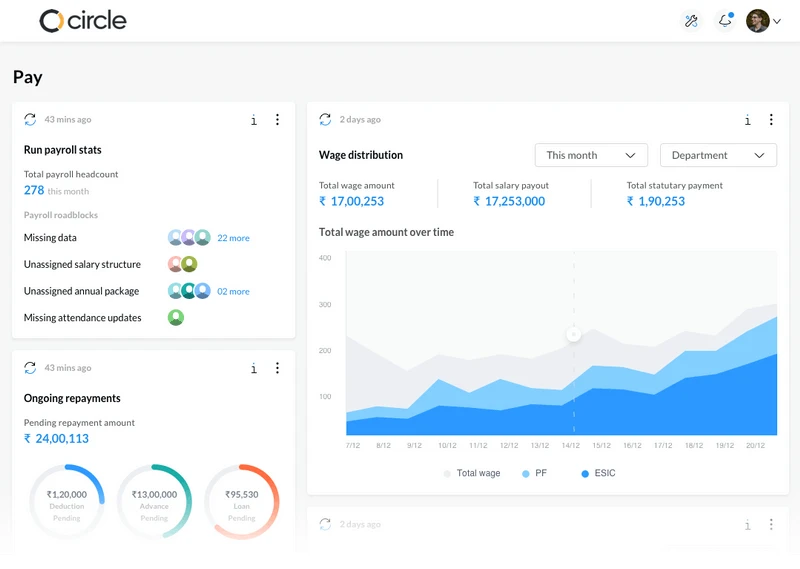While a HR budget might seem like a challenging task, it isn’t always the case. A well-thought-out HR budget ensures the company has adequate funds to support employee initiatives and development programs. In addition, budgets for human resources are developed to specify how much money should get allotted for various costs and departments during the calendar year.
In addition, a good workforce engagement is every modern company’s top priority in 2022, and they always strive to retain top people to improve their brand reputation. Therefore, every contemporary HR professional should consider key factors when creating a new HR budget plan.
HR Budget: A Brief Overview
A company’s total rewards program includes HR incremental budgets extensively. The budget gives a general overview of what must be done and how much it will cost to meet the organisational goals.
Thus, an organisation’s annual projection of expenditures and costs for human resources is called the HR Budget. It gives the business an estimate of the numbers used to create the annual budget.
However, the “Human Resource Plan” can be a little deceptive. The entire process can come down to just hiring and staffing-related costs. It is a much wider perspective that enables a business to clearly understand what it needs for each employment position.
Developing a sound HR budget implies considering the crucial resources required each year. Hence, it is better to concentrate on the essentials without overpaying staff attendance incentives your company doesn’t require. This way, you can better develop a realistic budget that supports your business’s expansion.
Factors to Consider When Creating an HR Budget
In the competitive world with changing priorities, all companies must reassess their HR budgeting process to guarantee effective annual administration. In addition, having an HR budget can assist with devising a reasonable budget for the forthcoming years. Here are some necessary factors that every HR manager must consider in their budgeting.
1. Employee Happiness
Individual workers consider happiness a top priority of workplace transformation. Therefore, businesses that embrace and modify flexible working arrangements reap significant financial benefits. Moreover, according to a report, 80% of employees globally reported feeling stressed out at work. They claimed that nearly half of them needed assistance to improve their general well-being.
Employee satisfaction is somewhere in the middle of the pack. Also, in 2020’s economic downturn, some companies had to reduce employee benefits. In turn, retention and staff morale have suffered. So HR professionals must prioritise better employee well-being activities that improve employee satisfaction and performance at work while budgeting. Doing this is essential to keep workers on board for a long time and reduce the financial resources wasted on frequent recruitment.
2. Flexible Awards and Acclaim
Regular performance evaluations and other manual rewards and praise employee programs are inefficient, lagging, and prone to human mistakes. They are also difficult to adopt in a workplace that prioritises work. Hence it might not be wrong to say that incentives for performance should be quick and automated instead.
In addition, HR departments usually have several significant duties, such as employee satisfaction and recognition. It can be difficult to find time to interact with employees individually due to the ever-growing responsibilities and scarce economic resources. So every time HR managers perform budgeting, they must consider the flexible awards and acclaims they can offer to their workforce.
3. Workforce Development
Currently, technology rules the human resources sector. When you visit a job portal, you will notice automated job advertisements. The resume and cover letter of job applicants are typically auto-populated into the job application by an ATS or document parser.
Automation not only saves a lot of time but also a lot of money. However, the eventual requirement for workforce shape is one significant disruption with HR automation.
Redefining worker roles and duties to suit the demands of a digitally altered workplace is known as “workforce shaping.” Furthermore, labour is frequently the single-largest expense for businesses. As much as 70% of organisational expenses might be attributed to labour costs. Businesses should start reorganising their workforces to meet the skills and talents needed in the future.
4. Give Diversity and Inclusion Projects Top Priority
According to research, DE&I (Diversity, Equity, and Inclusion) recruitment efforts will likely receive a third of company expenditures. Organisations must first evaluate the duties they must carry out and the goals they wish to achieve to calculate the proper budget for DE&I. Moreover, it is important to find any pay discrepancies for disadvantaged groups regarding compensation. Companies should decide what D&I goals they want to achieve and what resources they can afford. Additionally, they must evaluate their D&I duties and create a strategy to fulfil them all.
5. Future-focused Workforce Reconstruction and Retraining
Digital transformation in modern times involves more than simply technology. Therefore, HR departments must be flexible and tech-savvy to assist their businesses in restructuring themselves to operate more effectively.
Due to the digital revolution, several aspects, including people management, performance appraisal, leadership, recruiting, and many others, need to be rewritten and rethought. However, it is crucial to remember that putting all these fresh concepts into practice will take time and money. As a result, you must be clear about what you want and explain how it would help other people.
Understanding the Benefits of HR Budget Planning
Budgeting for human resources is essential as it ensures that your company has adequate funding and enables you to attract and retain the best talent pool. Here are some prominent benefits of a HR budget plan.
- HR Budgeting Prevents Overhiring
Training and development is far better than spending too much time and energy hiring new personnel. Many individuals believe that if they have more money, the more they can allocate to the recruitment budget or talent acquisition budget. Employers hire more employees than they can effectively manage, train, and retain. However, you can better reduce excessive spending on employing extra personnel by implementing an effective HR budgeting strategy.
- An HR Budget Aids Businesses in Determining Their Staffing Needs
By offering a useful framework, HR budgeting aids firms in properly managing staffing numbers. This structure has been specially designed to satisfy the special requirements of various companies and their major stakeholders. Making wise hiring selections is aided by realistic budgeting for business leaders. The company can strategically manage its financial investments in its staff in this way. Keeping track of how much is spent on each employee for various purposes might help you improve your business strategy.
- HR Budgeting Prevents Understaffing
One can reduce these expenditures by efficiently adopting a transparent and uniform compensation budget that unifies all allowed actions. Using a budget may prevent your company from having too many or too few employees. It avoids costly mistakes that can happen when resources are overextended. Understaffing is no longer a problem because of efficient resource allocation. It enables a workforce to meet the highest performance standards without endangering financial outcomes.
- Budget for HR Aids in Lowering Employee Turnover Rate
Any firm must have a solid budgeting approach, especially with excellent employee retention. In addition, analysing the rate of employee turnover needs strong analytical abilities and the capacity to reach challenging judgments. Employees can plan their financial year with the aid of an annual HR budget. It supports managers in making wise choices about personnel recruitment, development, and training.
- HR Budgeting Assists in Recruiting Talented Employees
Creating an HR budgeting system is one method to increase your capacity to recruit and keep personnel. Using a comprehensive HR budgeting system, you can allocate funds to the expenses of the hiring process, such as employee salaries and benefits. You may assess the effects of each new hiring by creating a set of guidelines for resource allocation.
The Bottom Line
For HR departments, managing expenses has always been a challenge. Making an HR budget plan is one of the most impactful solutions that help HR managers overcome workforce challenges, overhead costs, and budgetary control issues. Moreover, the primary objective of HR budgeting is to assign resources within a business. It guarantees that the company fulfils its mission and purposes while reducing ineffective or wasteful activities. In addition, without proper HR budget procedures, workers can lose productivity and enthusiasm. Eventually, it will lead to reduced productivity and incapacity to perform their best.
Additionally if you’re looking to save money in your budget, get a sumHR HRMS for free, an all in one payroll & attendance management software. Book a demo.
FAQs
1. What is a recruitment budget?
A recruitment budget is a recruitment cost formula adopted by businesses and human resources departments to manage all hiring-related expenses.
2. What should you include in the HR budget?
A HR budget will comprise the funds allocated to salaries, recruitment, benefits, training, talent management, succession planning, employee wellness planning, and workforce engagement.
3. How are HR budgets calculated?
HR budgets are usually calculated by evaluating financial information, performance results, and historical information from every division.
4. How much is a standard HR budget?
Generally, HR budgets remain between two and four percent of cumulative revenue.
5. What are the five P models of human resource management?
The five P models of HRM are: principles, purpose, processes, people, and performance.








